Has the Time Come to Eliminate Coal as An Energy Source? Be Careful What You Wish For.

This article describes the current state of the U.S. coal industry, providing a data-driven analysis of what is often described in emotional and political terms. With natural gas providing a lower-cost alternative and proponents of the Green New Deal and other advocacy groups campaigning
to reduce or eliminate coal from the nation’s energy sources, the industry is under pressure from both economic and political forces. The paragraphs below summarize the industry, its markets and perhaps its future.
In October 2019 Ohio-based Murray Energy, the largest privately-owned coal company in the United States, filed for Chapter 11 bankruptcy. This followed privately-owned, Kentucky based Blackhawk Mining, LLC and publicly-owned, Wyoming-based Cloud Peak Energy, both of which declared bankruptcy earlier the same year. Other, smaller mining companies have also filed for bankruptcy in 2019, or have reduced operations.
The Coal Industry Today
Coal consumption in the U.S. peaked in 2008 and has since trended downward. At present, the majority of coal consumed in the U.S. is used in power plants to generate electricity. The percentage of power generated from these coal plants continues to decrease each year, displaced primarily by natural gas rather than renewables. While the Wind and Solar categories continue to expand, they still represent less than 4% of the total energy consumed in the U.S. and about 9% of total power generation. The shift from coal to renewables will likely remain slow and steady. There is no quick fix. While the U.S. is significantly reducing coal consumption overall, the rest of the world continues to be heavily coal reliant, with U.S. consumption representing an ever-smaller percentage of total world consumption. As such, domestic coal curtailment, while an admirable objective, is not likely to “save the world.”
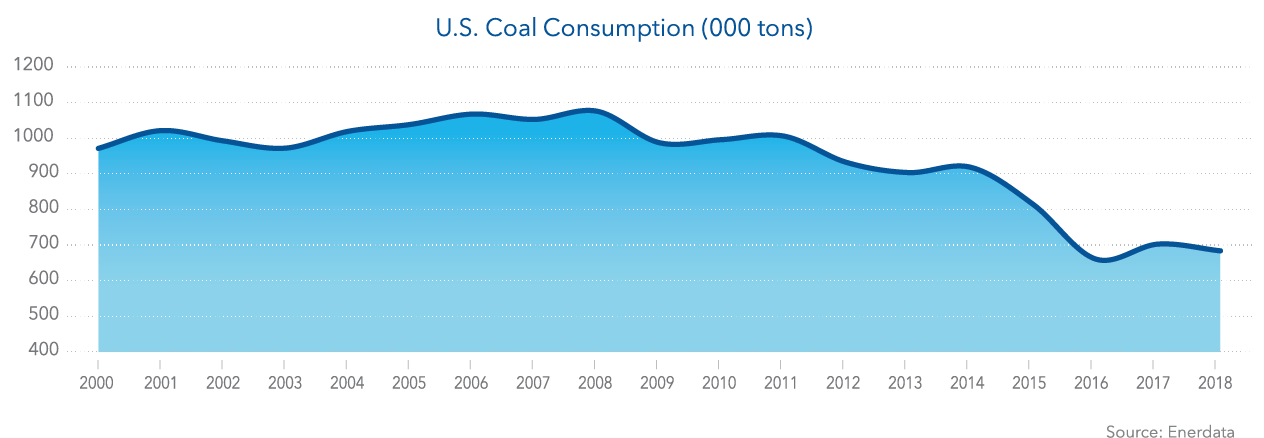
How We Get Coal and Where it Comes From
Coal is the byproduct of decaying plants and animals that lived millions of years ago under certain geologic conditions. It naturally occurs in layers, often referred to as “seams,” of varying thickness from as little as a few inches up to 100 feet. Mountainous regions like West Virginia and Kentucky contain multiple coal seams at different elevations, each corresponding to a different era in history. Coal is concentrated in certain geographic regions referred to as “basins;” the Illinois Basin, the Appalachian Basin, the Powder River Basin, and others. Typical types of coal are: bituminous, anthracite and lignite.
Coal is extracted through either surface or underground mining. Surface mining is primarily accomplished through an open pit method where the mining company removes the rock “overburden” to expose and extract the coal seams. As the pit advances, the miners use rock extracted today to backfill areas disturbed in prior periods in a process of continuously disturbing and restoring the site.
In the Appalachian region, with its mountainous terrain, surface mining may include both area mining and contour mining in recovering multiple coal seams at different elevations. Mining is heavily regulated at both the state and federal levels such that mined areas are returned to their closest original contours, structured to control runoff and minimize erosion, and replanted to restore a natural appearance.
Underground mining utilizes self-propelled vehicles mounted with a spinning drum that cuts into the coal and rock to harvest coal and create parallel tunnels. In areas where geological conditions are optimal, longwall mining equipment is used. This mining method utilizes specialized mining machines operating side by side in a “wall” up to 1500 feet wide, mining coal and slowly advancing to extract millions of tons per year in certain conditions.
Types of Coal
Metallurgical Coal and the Steel Industry
A limited portion of the world’s coal has certain physical and chemical properties that make is suitable for use in steelmaking blast furnaces. Metallurgical coal is combined with iron ore and limestone and melted in blast furnaces to form liquid iron, which is further purified into steel.
The United States has a mature economy. Each year cars, buildings and bridges are demolished and the resulting steel is reprocessed by a highly efficiently scrap industry. Steel can be infinitely recycled. Scrap steel is remelted in electric arc furnaces or mixed with blast furnace steel and made into new products. About 75% of the steel made in America today comes from scrap or scrap substitutes such as “pig iron,” rather than through the traditional blast furnace method.
Countries like China and India, on the other hand, have immature economies. They consume much more steel than they could ever generate from scrap flows. As a result, they are primarily reliant on blast furnace operations and in turn on metallurgical coal. As long as the world uses steel, it will use metallurgical coal, and the emerging economies are far more reliant on metallurgical coal than we are here in the U.S.
Steam Coal
The vast majority of coal mined in the U.S., and the rest of the world, is steam coal (also referred to as thermal coal). Steam coal is burned at power plants to create heat for the purpose of boiling water, that then produces the steam that drives the turbines which produce electricity. To a lesser extent, steam coal is also used to produce industrial process steam and building heat for industrial and municipal building complexes.
The value of Steam Coal is based on its BTU content, ash content (noncombustible content within the coal), sulfur content, and other factors. Mining cost are based on geological conditions; how thick the coal seams are, how far underground are they, how much rock the company needs to mine and dispose of in order to extract the coal. Transportation cost from the mines to customers is based on accessibility to rail, barge or truck transport. For coal mined in geographies such as Wyoming and other distant locations, the cost of transportation to customers may actually be greater than the mining cost itself.
The Realities of Current Coal Production
In 2018, U.S. coal production totaled 756 million tons including 275 million tons derived from underground mining and 481 million tons from surface mining. Steam coal represented 677 (90%) million tons with metallurgical coal representing 79 million tons. The U.S. is a major coal exporter and coal exports totaled 115.6 million tons in 2018; about 15% of total production. Steam coal exports totaled 54 million tons and metallurgical coal 62 million tons.
Although many of us would think of Appalachia first when discussing coal, Wyoming is by far the leading coal producing state. The Powder River Basin (PRB) covers parts of Wyoming and Southern Montana with rich coal seams up to 100 feet thick which supply more than 40% of coal mined in the U.S., the vast majority recovered through open pit mining.
While coal mining takes place in 23 states it is generally a minor part of each state’s total economy except for Wyoming, Kentucky and West Virginia where coal represents a significant part of the state’s economy- directly through mining companies and their employees and indirectly through suppliers and service companies. In other states, Coal is a major economic engine only in those areas where coal companies and their suppliers are the major regional employers. About 53,000 U.S. workers are presently employed in the coal mining industry.
As environmental groups actively call for the reduction of coal mining and use, to some extent, the horse has already left the barn with U.S. consumption decreasing from over a billion tons in 2011 to 684 million tons in 2018. Since most domestic coal is used in power generation, the majority of the decrease in U.S. coal consumption, has come from the closure or curtailment of coal burning power plants. This change was brought about by cost competition from natural gas and from governmental restrictions enacted under the Obama White House and previous administrations.
While President Trump has rescinded certain Obama-era legislation, many of the plants scheduled to close during the Obama administration have closed or will, in fact, close in the coming years.
According to the U.S. Energy Information Administration (EIA) between 2010 and the first quarter of 2019, U.S. power companies announced the retirement of more than 546 coal-fired power units, totaling about 102 gigawatts (GW) of generating capacity, with another 17 GW scheduled for closure by 2025. U.S. current capacity is approximately 250 GW with most of those plants operating at less than maximum capacity. Certain utility companies have evolved to a multiple source model featuring coal, gas, wind, or solar and enjoy the flexibility of adjusting output to minimize cost while providing consistent service to the customer base.
To understand the coal industry, we at Hilco believe that it is important to first grasp the broader concepts of U.S. energy supply and consumption; energy to heat houses, move vehicles, operate machinery and create electricity. Petroleum, used almost exclusively to produce gasoline, remains the largest source of domestic energy for all purposes followed by natural gas, coal, nuclear and then by renewables such as: biomass, Hydro, geothermal, wind and solar. As the below chart illustrates, coal as a percentage of the U.S. total energy supply has trended downward, decreasing from 22% in 2008 to 13% in 2018. As coal usage has decreased, natural gas usage has increased from 24% in 2008 to 31% in 2018-shifting from one fossil fuel to another. Wind and solar increased from less than 1% in 2008 to 3.5% in of total energy supply 2018 and remain a small portion of
total U.S. energy generation. Fossil fuels represented 80% of the U.S. energy supply in 2018 with Nuclear at 9% and all renewables at approximately 11%. Among the non-fossil sources, Nuclear and Hydroelectric output is essentially fixed, the country isn’t damning rivers to run power plants nor is it rushing to expand the Nuclear fleet. So, baring new technology break-throughs using hydrogen, algae or other sources, the growth in renewables will likely come from wind and solar.
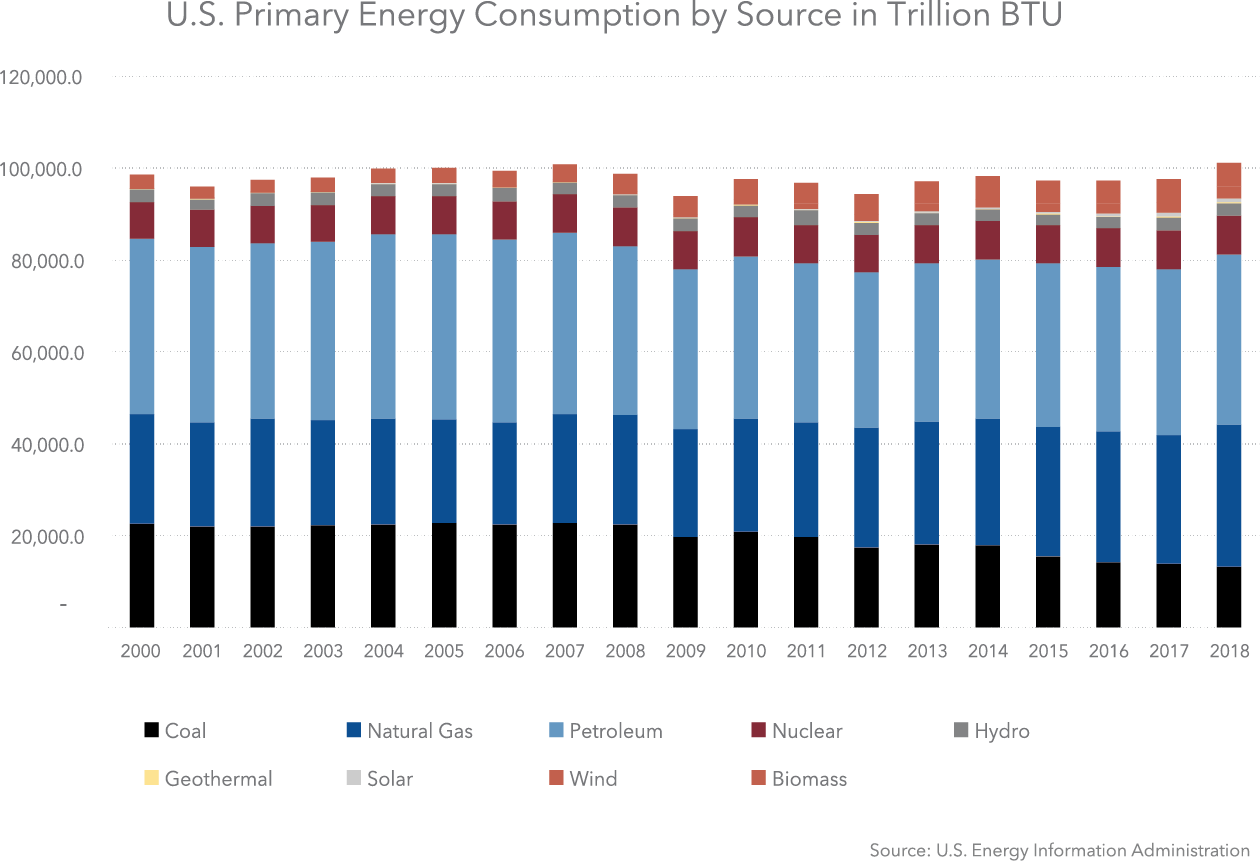
While the growth in renewable energy has been slow, it continues to accelerate. According to the American Wind Energy Association (AWEA), the installed wind power capacity in the United States reached 100 GW in the third quarter of 2019 (from over 94 GW at the end of 2018), enough to supply power to 32 million US households.
The AWEA expects wind power to continue to gain momentum. In the third quarter of 2019, the near-term wind project pipeline grew to 46.5 GW, which is nearly half the current installed capacity. According to the association, 22.6 GW of wind capacity is under construction and an additional 23.8 GW is in advanced development, including 5.8 GW of offshore wind. In addition, project developers announced 10 GW of new projects in the third quarter of 2019.
The movement towards renewables and away from coal, and the shuttering of the worst polluting coal burning plants has contributed to a significant reduction in CO2 from power generation. While coal consumption for power generation is decreasing, it still represents about 65% of the Carbon Dioxide emissions resulting from power generation. CO2 from natural gas fired power plants has increased in recent years as natural gas displaces coal in the energy generation capacity mix. From a C02 perspective the power industry is moving in a slow but positive direction. While the trend is in the right direction, renawable wind and solar grew from almost nothing in 2000 to 9% of power generation, a transition of about one-half of a percent per year. A quick move from fosssil fuels to wind and solar would require the replacement of more than 70% of existing generation capacity- and at what cost?
“Over There” vs. “Right Here”
If we are concerned about global warming or climate change – take your pick – then a ton of coal burned “over there” is just as detrimental to the planet as a ton burned right here in our own country. While the U.S. has sharply curtailed coal usage, the rest of the world has increased consumption, primarily due to the ongoing industrialization of India and China. U.S. coal consumption represented 21% of world consumption in 2000 but only 9% in 2018. Chinese consumption including both metallurgical and steam coal peaked in 2013 and has since trended downward but still represents almost half of the world’s total consumption.
According to a recent Reuters article, China has current plans to add an additional 226 gigawatts of coal fired capacity-almost as much as total existing U.S. capacity. Chinese total coal fired capacity is expected to increase from its current 1,020 gigawatt capacity to stabilizing at approximately 1,300 gigawatts. On the other hand, the U.S. has a single, 17 megawatt (0.017 GW), coal fired power plant under construction at the University of Fairbanks in Alaska.
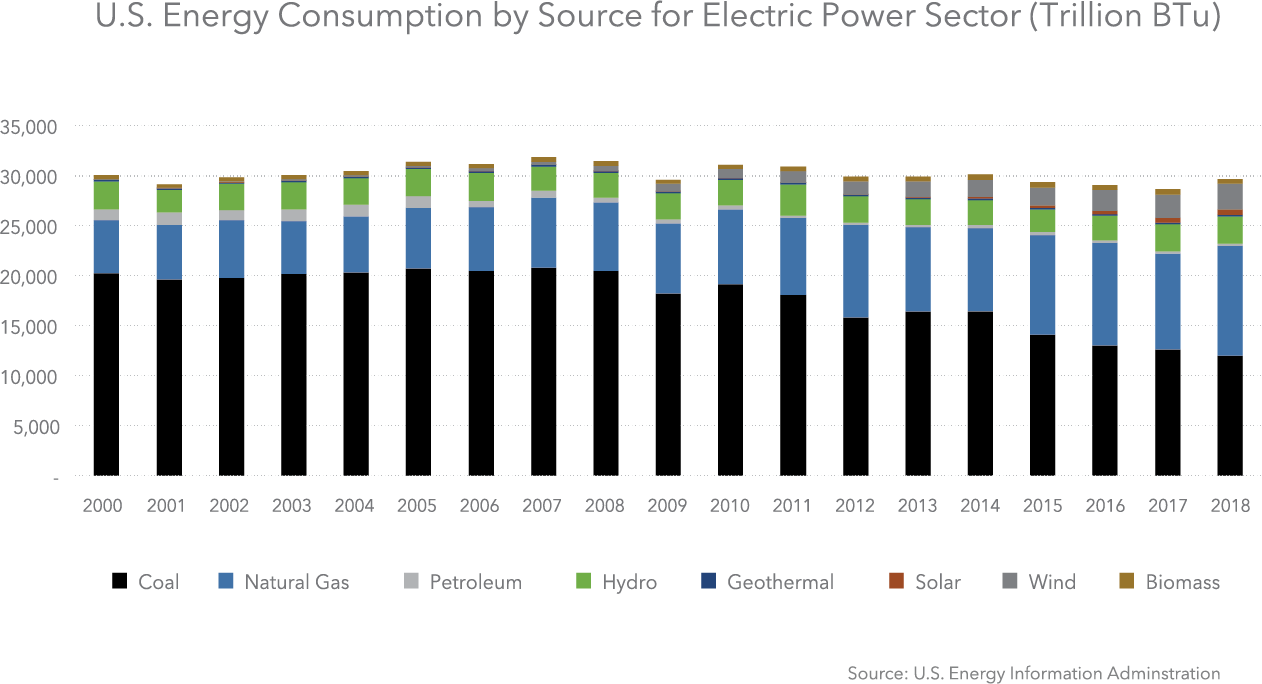
In addition to expanding domestic capacity, a recent Institute for Energy Economics and Financial Analysis (IEEFA) report finds that Chinese financial institutions—both the development finance institutions and state-controlled banks— have committed or offered funding for over one-quarter (102 gigawatts GW) of the 399GW of coal plants currently under development outside China, including investment in export coal mines, coal-fired power plants, and the associated rail and port infrastructure.
Over the past 20 years, the overall share of coal in the world power mix has remained relatively steady at near 40%. As a result, coal is still the most widely used energy source for electricity generation in the world. In fact, if the U.S. never burned another pound of coal, that effort to curtail production would reduce the world’s coal consumption by only 9% at current usage rates, and less so in the future. Furthermore, it would decrease U.S. total consumption of fossil fuels by far less than that, since petroleum remains our largest energy source.
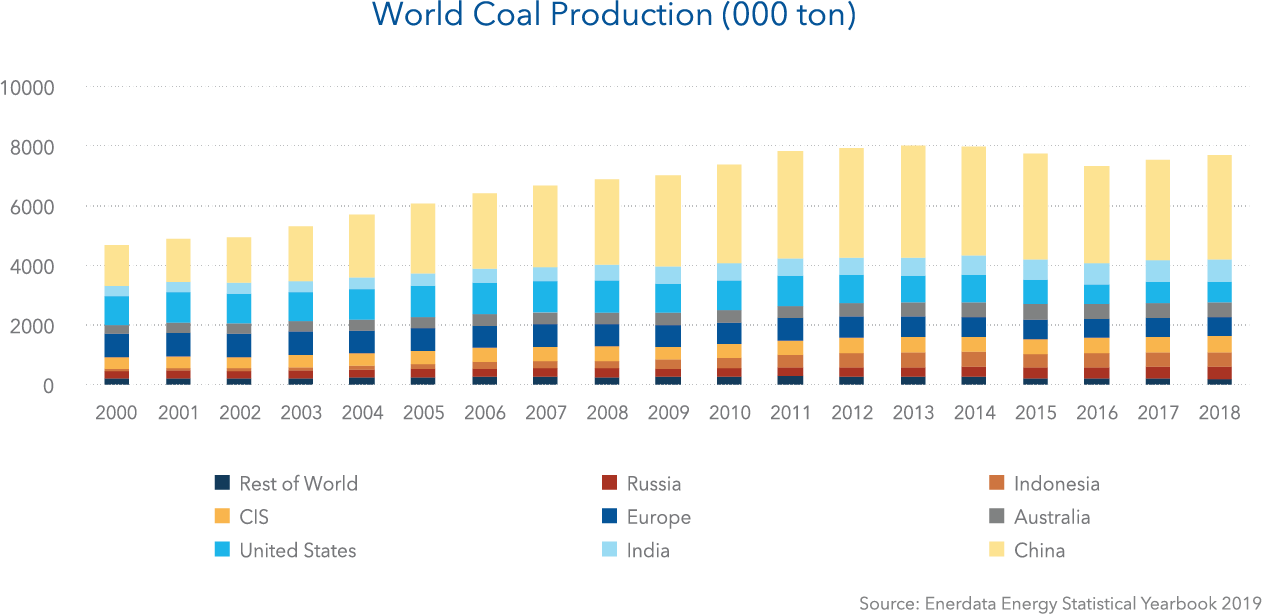
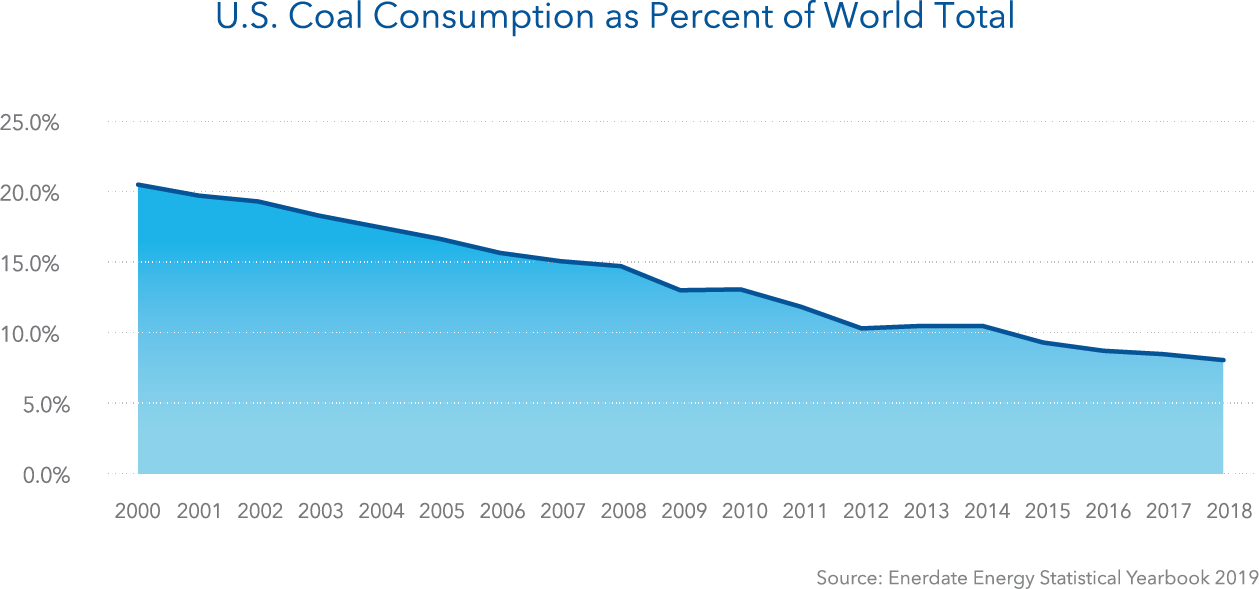

One idea for curtailing that has been proposed is a so-called “carbon tax,” that would make consumption more expensive and encourage energy conservation, which would certainly appear to be a good idea. However, a carbon tax would make the domestic production of goods more expensive, pushing that production offshore to countries more reliant on coal. This, therefore, would seem shortsighted as it may likely result in increased coal usage in other countries and higher worldwide emissions overall. Add to that increase the added emissions generated from transporting raw materials to China and other low-cost producers, and then transporting the finished goods back to the U.S. So, a carbon tax not applied equally in all countries, would seem ill conceived as a means of curtailing emissions.
Virtually everyone on the planet, including coal miners, would tell you that burning less fossil fuels, of all types, is a good thing; the question is… how do we do that? The U.S. has always tried to be a leader of progressive and positive values and a rapid (and costly) movement from coal would be a positive example to the world, but one that other countries might not follow. Mathematically speaking, as the world consumes more coal and we consume less, the effort becomes more symbolic than effective at changing things on a global scale.
While Americans talk the talk, we don’t necessarily walk the walk… or more accurately drive the drive. The author’s beloved 1982 Chevrolet Chevette achieved 34 miles per gallon-37 years ago, about 16 miles above the current fleet average, which has only risen from 16.9 mpg in 2000 to 18.1 mpg in 2017. While technology is making our cars lighter and more efficient, we cling to SUV’s and light trucks, rather than the more mundane and higher mileage sedans and minivans. America’s transition to SUV’s can be traced to another well-intentioned governmental act- The Corporate Average Fuel Economy (CAFE) Standards enacted in 1975 to force improvement of average fuel economy. The CAFE standards initially excluded light duty trucks, and the automotive companies marketed luxury trucks and truck/car hybrids which morphed into the school bus sized SUV’s we drive today.
Where the Industry is Headed
- HIlco sees demand for metallurgical coal continuing at current rates.
- Most metallurgical coal mines are running near capacity and will likely remain profitable.
- Demand for steam coal domestically will likely continue to decrease but remain strong globally.
- As steam coal mines throttle back output, many will experience diseconomies of scale and struggle financially.
- Some well-led companies will emerge from bankruptcy as highly competitive industry players.
- The transition to Solar and Wind will continue but likely take decades rather than years.
- The recent consolidation trend will also continue with stronger companies buying weaker ones.
- Mergers and joint ventures will continue with the industry shifting toward an oligopoly that could better control supply and will have increased price bargaining power.
- While the U.S. moves away from coal, the rest of the world will consume more and U.S. exports will likely increase.
Justifiably or not, coal is to global warming as Freddie Kruger is to Halloween. Focusing on coal as both the culprit and the solution to all that’s wrong with the world allows us to ignore or downplay other methods and sources. It’s less painful to accept a coal miner losing his job than it is to give up driving our own SUV’s. Similarly, it’s easy to buy those less expensive products from China while turning a blind eye to how much energy was actually used moving iron ore and coal from Australia to China and then shipping those goods out to buyers around the world.
Based on what we read and hear today, one could justifiably believe that there is a massive switch somewhere that could be turned to the “on” position in order to transition the United States from fossil fuels to renewable fuels. The result would be the end of global warming and the CO2 build up, lung disease and a host of other benefits; but we believe the reality is probably more disappointing and after coal, difficult choices would most certainly have to be made. From Hilco’s perspective, an accelerated movement away from coal, for example, would likely lead to the closure of mines, leaving limited funds for requisite restoration, while a more gradual decrease in consumption would continue to provide funds for that purpose; and that’s just one of many potential consequences.
By most measures, it is likely that the use of steam coal will continue to decrease in the U.S., plateauing at between 30 to 50% of current capacity, and existing primarily as a backup for days without sunshine or wind. Ultimately, when coal has ceased to be a major energy source, we will be faced with harder choices about how we live, what we drive and what we consume. So. be careful what you wish for.
Globalization, trade and tariffs, fracking and renewable resources, rapidly changing technologies and changing social and political views will combine to bring change to many of the industries that currently drive the U.S. economy and lenders to those industries will no doubt want to keep a close eye on their metals and mining industry portfolios with an emphasis on assessing performance and risk.
Hilco valuation teams work in machinery, equipment and enterprise valuation for numerous companies in the metals and mining industry and thoroughly understand the unique dynamics of price volatility on manufacturers, distributors and fabricators. Hilco has unparalleled market trend data to assist our customers in ongoing assessment of how market forces drive recovery values. If you’re looking for a thorough process and a proven partner to help you gauge metals recovery values in your portfolio or your business, give us a call.


